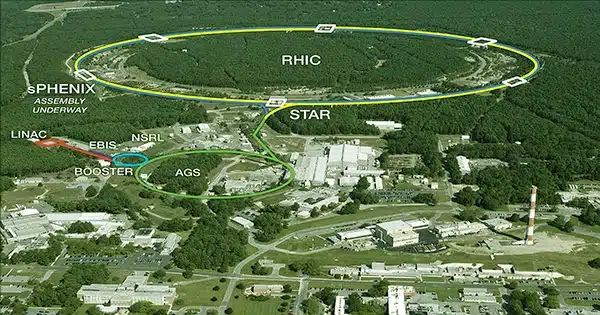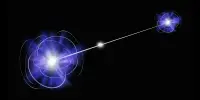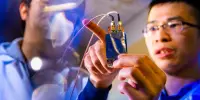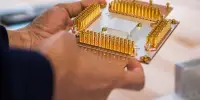The first observation of the directed flow of hypernuclei has been announced by physicists researching particle collisions at the Relativistic Heavy Ion Collider (RHIC). These unusual, short-lived nuclei have at least one “hyperon” in addition to protons and neutrons.
Hyperons have at least one “strange” quark in place of one of the up or down quarks found in regular nucleons (protons and neutrons combined). Such unusual matter is predicted to be plentiful in neutron star cores, which are among the densest and most bizarre objects in the universe. While traveling to neutron stars to investigate this exotic matter is still science fiction, particle collisions could provide scientists with information about these celestial objects from a laboratory right here on Earth.
“The conditions in a neutron star are still far from what we reach in the laboratory at this point,” said Xin Dong, a physicist at the US Department of Energy’s Lawrence Berkeley National Laboratory (LBNL) who was involved in the work. “By comparing our data from this laboratory environment to our theories, we can try to infer what happens inside the neutron star.”
The scientists studied the flow patterns of the debris released from gold nuclei collisions using the STAR detector at RHIC, a DOE Office of Science user facility for nuclear physics research at Brookhaven National Laboratory. The massive pressure gradients caused by the collisions cause these patterns to emerge.
They intended to obtain insight into interactions between hyperons and nucleons by comparing the flow of hypernuclei to that of identical ordinary nuclei made entirely of nucleons.
“Nucleon-nucleon interactions form normal atomic nuclei in our normal world.” “However, as we move into a neutron star, hyperon-nucleon interactions—which we don’t know much about yet—become very relevant to understanding the structure,” said Yapeng Zhang, another STAR member from the Chinese Academy of Sciences who led the data analysis with his student Chenlu Hu. Following the flow of hypernuclei should provide scientists with information about the hyperon-nucleon interactions that produce these strange particles.
The data, which was recently published in Physical Review Letters, will provide quantifiable information that theorists may utilize to strengthen their descriptions of the hyperon-nucleon interactions that drive hypernuclei formation—as well as the large-scale structure of neutron stars.
“There are no solid calculations to really establish these hyperon-nucleon interactions,” Zhang explained. “This measurement may potentially constrain theories and provide a variable input for calculations.”
Go with the flow: Previous tests have demonstrated that the flow patterns of normal nuclei generally scale with mass, which means that the more protons and neutrons a nucleus has, the more it exhibits collective flow in a specific direction. This implies that the flow of these nuclei is inherited from their constituent protons and neutrons, which coalesce or come together as a result of their interactions mediated by the strong nuclear force.
According to the STAR results presented in this study, hypernuclei exhibit the same mass-scaling pattern. As a result, hypernuclei are most likely formed by the same mechanism.
“In the coalescence mechanism, the nuclei (and hypernuclei) form in this way depending on how strong the interactions are between the individual components,” Dong explained. “This mechanism gives us information about the interaction between nucleons (in nuclei) and nucleons and hyperons in hypernuclei.”
The scientists believe that seeing similar flow patterns and mass scaling relationships for both regular nuclei and hypernuclei shows that nucleon-nucleon and hyperon-nucleon interactions are quite similar.
The flow patterns also communicate information on the matter produced by particle smashups, such as how hot and dense it is, as well as other qualities.
“In the coalescence mechanism, the nuclei (and hypernuclei) form in this way depending on how strong the interactions are between the individual components,” Dong explained. “This mechanism gives us information about the interaction between nucleons (in nuclei) and nucleons and hyperons in hypernuclei.”
The scientists believe that seeing similar flow patterns and mass scaling relationships for both regular nuclei and hypernuclei shows that nucleon-nucleon and hyperon-nucleon interactions are quite similar.
The flow patterns also communicate information on the matter produced by particle smashups, such as how hot and dense it is, as well as other qualities.
The benefits of low energy: This study would not have been conceivable without RHIC’s ability to work across such a wide range of collision energies. The observations were taken during Phase I of the RHIC Beam Energy Scan, which was a systematic examination of gold-gold collisions with energies ranging from 200 GeV per colliding particle pair to 3 GeV.
RHIC used “fixed-target” mode to achieve the lowest energy: One gold ion beam moving around the 2.4-mile-circumference RHIC collider collided with a gold foil placed inside the STAR detector. Because of the low energy, scientists can obtain the maximum “baryon density,” a measure related to the pressure generated in collisions.
“At this lowest collision energy, where the matter created in the collision is very dense, nuclei and hypernuclei are produced more abundantly than at higher collision energies,” stated Yue-Hang Leung, a postdoctoral fellow from Heidelberg University in Germany. “The only collisions that produce enough of these particles to give us the statistics we need to do the analysis are low-energy collisions.” Nobody has ever done anything like this before.”
What did the scientists learn at RHIC have to do with neutron stars?
The fact that hypernuclei appear to form via coalescence in the same way that conventional nuclei do suggests that they, too, are formed at a late stage in the collision system’s evolution.
“At this late stage, the density for the hyperon-nucleon interaction that we see is not that high,” Dong explained. “As a result, these experiments may not accurately simulate the environment of a neutron star.”
“This data is new,” he noted. We need to hear from our theory buddies. When developing a new neutron star model, they must incorporate this new data on hyperon-nucleon interactions. We need the efforts of both experimentalists and theorists to grasp this data and make those linkages.”













